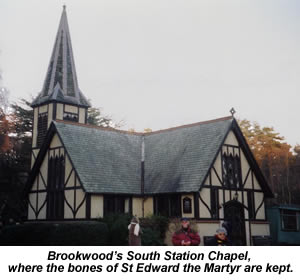 In the sixty years since 1941, almost all physical evidence of the Necropolis line has disappeared. The frontage of the Westminster Bridge Road station is still there, although the words “London Necropolis” which once appeared over its main entrance have gone. There's still a train service from Waterloo to Brookwood, but all the rail lines inside the cemetery were removed in about 1947.
In the sixty years since 1941, almost all physical evidence of the Necropolis line has disappeared. The frontage of the Westminster Bridge Road station is still there, although the words “London Necropolis” which once appeared over its main entrance have gone. There's still a train service from Waterloo to Brookwood, but all the rail lines inside the cemetery were removed in about 1947.
The two cemetery stations survived for a while as refreshment bars, but both have now been demolished. North Station (by then North Bar) was closed around 1956 and demolished in the early 1960s because of dry rot. South Station (South Bar) was closed in about 1967 and used as a mortuary and storage building for the next five years. In September 1972, it was badly damaged in a fire thought to have been set by vandals, and bulldozed soon after. All that remains of the two cemetery stations now is their platforms, complete with the characteristic dip in their trackside edges to help LNC staff unload coffins from the hearse vans' bottom shelves.
The two stations' chapels have also survived. South Station Chapel has been carefully restored by the St Edward Brotherhood, an orthodox order of monks who worship at the chapel and maintain a shrine there containing the bones of St Edward the Martyr. The Brookwood Cemetery Society conducts regular walking tours of the cemetery, following the route of its old railway line and pointing out the odd bit of track hardware which remains.
Despite losing so many of its relics, the Necropolis Railway continues to exert a strong hold on writers' imagination. The first book to tackle the subject in recent years was Basil Copper's Necropolis, a 1980 crime novel which uses the funeral trains as its setting. The first edition of John Clarke's history of the service followed in 1983 and Andrew Martin's murder mystery in 2002.
Clarke first became fascinated by the trains in the mid-seventies, when his interest in the First World War led him to visit Brookwood's Commonwealth War Graves section. Strolling round the cemetery at random, he chanced on the remains of North Station, and wondered what a railway platform was doing in the middle of a cemetery. From that moment onwards, he was hooked. “It was the unusual nature of the railway that drew me in,” he says. “It was the first railway funeral service in the world and, as far as I'm aware, it was the one that lasted the longest.”
Martin's interest was sparked when researching Waterloo Station for his Tube Talk column in London's Evening Standard. “I bought a copy of the Oxford Companion to British Railway History, and I came across in there,” he recalls. “All the time I was writing Tube Talk, I kept on coming back to it. It was so moody and so atmospheric. The whole thing seemed to have been invented exactly so that someone could write a novel about it.
“But, of course, it was very logical. It remains logical. I think it would be rather nice to be carried to your last resting place on a train.”
This article first appeared in Fortean Times 179 (January 2004). The Brookwood Cemetery Society offers regular guided tours, including one which follows the route of the old rail line. For details, see www.tbcs.org.uk.
Adam Leat's short film about the Necropolis Railway, which he built round a PlanetSlade interview narrating the story, can now be viewed on-line here.
Episode 43 of Monocle Radio's The Urbanist opens with PlanetSlade discussing The Necropolis Railway. First broadcast August 11, 2012. Free audio here.
Sources
In writing this article, I have drawn heavily on the information in John M Clarke's The Brookwood Necropolis Railway (Oakwood Press, 1995). It's available here.
Other sources inlude:
* An Introduction to Brookwood Cemetery, by John M Clarke (The Brookwood Cemetery Society, 2002).
* Charles Bradlaugh: The Man of Action who Founded the National Secular Society, by David Tribe. National Secular Society website (www.secularism.org.uk).
* Guinness Book of Records, edited by Norris and Ross McWhirter (Guinness Superlatives Limited, 1970).
* The Times London History Atlas, edited by Hugh Clout (Times Books, 1997).
* The Charlestown Curve Derailment of June 1912, by Stuart Morris (Platform, Winter 2001).
* Express Wrecked Near Hebden Bridge, by “our own reporters” (The Halifax
Courier, June 22, 1912).
* Great Lives of the Century, edited by Arleen Keylin (New York Times Company / Arno Press, 1977).
* Necropolis, by Basil Copper (Sphere, 1981).
* The Necropolis Railway, by Andrew Martin (Faber & Faber, 2002).